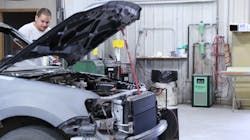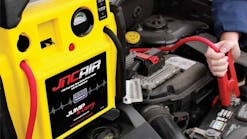Guest Blog: Considerations when buying your first industrial air compressor
Growing your business can be both exciting and overwhelming. Typically, one of the pieces of equipment you will need to consider upgrading is your air compressor. When your big box store compressor can no longer handle your air demand, you may need to start looking into industrial duty air compressors. The journey into industrial air compressors can be overwhelming, so in this blog, we will answer some common questions regarding compressor capacity and system demand to get you started in the right direction.
There are many variables to designing an optimal and scalable air solution for your growing business. Reach out to your local certified Sullair distributor to request an air audit. An air audit can not only identify the correct equipment for your company but may also identify new opportunities in your air system to create a more efficient system like flow controllers and point of use receiver tanks resulting in a lower total cost of ownership.
How much air (CFM) do you need?
This seems like a simple question, but it has caused issues in many installations. Cubic feet per minute (CFM) represents how much airflow a compressor can produce, or an air tool consumes, and there are many variables that can affect the performance of the compressor you buy.
Variables like altitude, room temperature, and humidity can significantly derate the capacity of your compressor. It is important that you take these factors into account when making your equipment selection. If you buy a compressor that is too big, you are wasting money and there can be several maintenance issues that can develop over time. If you buy too small, then you will not be able to operate the tools you need to keep your business open and the compressors can also develop maintenance issues over time. To over-simplify the answer, you must understand the CFM demand of your factory during peak times and find a compressor that will deliver the required CFM in your operating environment.
Manufacturers specify CFM in many measurements – How can I understand the difference?
Air has a different density at different ambient conditions. Because of this, compressor and tool manufacturers will typically specify CFM in one of four measurements: CFM, ACFM, SCFM, and ICFM. For this blog let’s discuss CFM, ACFM, and SCFM.
In compressors, CFM by itself is an unqualified unit of measurement and should never be used for sizing equipment. If you are considering a compressor that only publishes CFM, clarify the unit of CFM with the manufacturer. Some manufacturers use displacement and CFM interchangeably and do not consider real-world conditions. Many mass retail compressor manufacturers will publish a CFM at an operating pressure. This data alone provides a false sense of information to the consumer that will often lead to disappointing performance. When the performance of these compressors is measured to CAGI or ISO standards they often perform at 50-75 percent of the published capacity. Always look for a compressor that notes their ratings are per CAGI or ISO standards to ensure you get the performance you are paying for.
Actual cubic feet per minute (ACFM) is the volume of air flowing through the compressor or useful air at the compressor discharge. ACFM is relatively consistent throughout the operating pressure range. Compressed Air & Gas Institute (CAGI) compressor manufacturing members, like Sullair, publish the flow of their compressor equipment based on ACFM and are certified to meet the published flow within +/- 4 percent. This certification ensures the customer is receiving equipment that performs as advertised.
Standard cubic feet per minute (SCFM) is the volume of air flowing at some standard pressure, temperature, and relative humidity condition. There are many standards, but there are a couple of common standards when evaluating compressors. CAGI’s compressor standards for SCFM are 14.5 PSIA, 68 degrees F, and 0 percent relative humidity while OSHA and NIST use the standard sea-level conditions of 14.7 PSIA, 68 degrees F, and 36 percent relative humidity. As you can imagine, the chances of your compressor running at the exact conditions of a standard are improbable, thus your compressor performance will be different than the standard. Regardless of the standard used, SCFM and pressure are inversely proportionate. This means the same compressor flow (SCFM) at 100 psig will be greater than the flow of the same compressor at 125 psig.
How can I determine what ACFM compressor to buy knowing the CFM of my demand?
There are multiple online tools that will help you convert SCFM to ACFM. Sullair has a simple tool available at www.Sullairinfo.com. Look in the section labeled “Calculators” then find the “Altitude Correction Calculator.” After completing a few simple questions, you can determine how much ACFM the compressor will need to satisfy your demand, or you can see how many ACFM your compressor will produce at your location.
For example, let’s say that you have determined your equipment needs 150 SCFM, but you are in Houston, Texas, and will run operations through the summer. Your average summer temperature is 92 degrees F with 75 percent relative humidity at sea level elevation. After correcting the SCFM to ACFM for your ambient conditions, you would need a compressor that produces 160 ACFM.
Why is bigger not always better?
More pressure and higher capacity are not always a good choice when choosing your next compressor. As was mentioned earlier, an oversized compressor can result in wasted money either through energy costs or service costs. For rotary screw air compressors, an oversized capacity compressor will result in a short cycling time. One of the issues with this is the short cycle time will not allow the lubricant to heat up to the point to “boil out” the entrapped water. This entrapped water will shorten the bearing life of the compressor. In rotary screw and reciprocating (piston) compressors, having a package that produces more pressure than what is required, you are paying for the extra work the compressor must perform to increase the air pressure from your working pressure to the compressors rated pressure. For a simplified example, if you are operating a shop that needs a compressor to power air tools and the rated operating pressure of your air tool is 90 psig, but your compressor unloads at 175 psig, you are paying for the compressor to increase the pressure an additional 85 psig. It would be more efficient to buy a compressor rated for 100 or 110 psig. You will not only get a higher ACFM compressor but will save on energy over time. Some may suggest that the higher pressure will provide more storage capacity so the compressor can keep up with peak demands. If that is an issue, try adding additional air storage at the point of use where the peak demand occurs. Adding an additional air receiver once compared to maintaining a compressor system that is rated at too high of pressure over the life of the compressor, you will see your total cost of ownership decrease.
Information provided by Sullair


